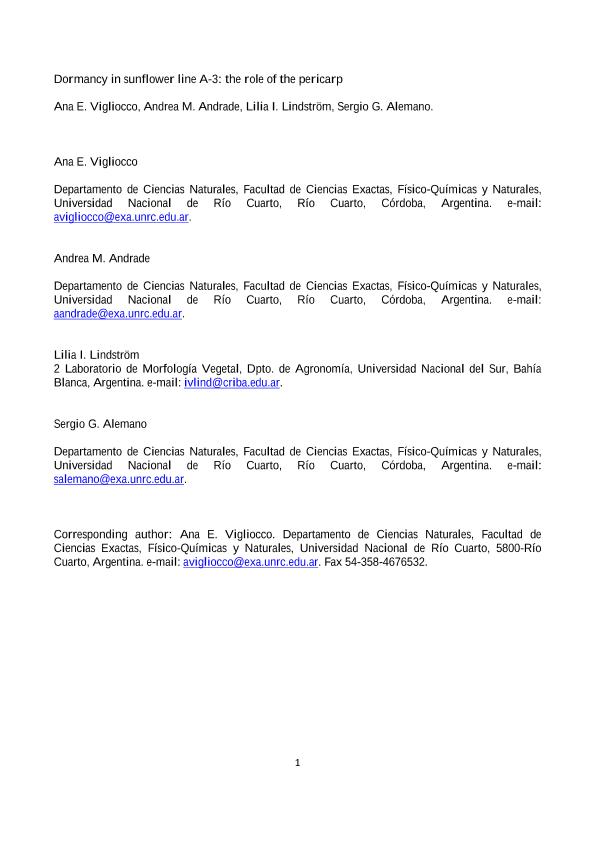Artículo
Sunflower (Helianthus annuus L.) can often display seed dormancy, which causes a delay for immediate sowing. The final degree of “whole seed” dormancy is determined by the contributions of the tissues that comprise it, such as, embryo, seed coat, and (or) pericarp. The sunflower dormancy can be reduced during after-ripening and by removing seed constraints. Our objective was to study how the conditions of storage and removal of the pericarp affect the level of dormancy in line A-3. Also we provide insight on the basis of the morphological characteristics of A-3 pericarp-imposed dormancy. A germination test was conducted on dry cypselas with and without pericarp, at 30 and 70 days after harvest. For histological analysis, permanent slides of pericarp crosssections were obtained. The germination percentage showed significant differences between cypselas with intact pericarp (30 days after harvest = 26%; 70 days after harvest = 77%), and cypselas without pericarp (30 days after harvest = 65%; 70 days after harvest = 96%). This indicates that the pericarp plays an important role in regulating physical dormancy in the seed of sunflower line A-3, and that its relative contribution to the dormancy level is modified during after-ripening. Le tournesol (Helianthus annuus L.) peut souvent présenter un repos germinatif qui cause un délai de l’ensemencement immédiat. Le degré final de dormance de la graine entière est déterminé par les contributions des tissus qui la comprennent comme l’embryon, l’enveloppe de la graine et (ou) le péricarpe. La dormance du tournesol peut être réduite durant la période postmaturation et en retirant les contraintes de la graine. L’objectif des auteurs était d’étudier comment les conditions d’entreposage et le retrait du péricarpe affectent le niveau de dormance de la lignée A-3. Ils fournissent aussi un aperçu du fondement des caractéristiques morphologiques de la dormance de A-3 imposée par le péricarpe. Un test de germination a été réalisé sur des cypsèles sèches avec ou sans péricarpe à 30 et 70 jours après la récolte. Des lames permanentes de coupes transversales de péricarpes ont été obtenues aux fins d’analyse histologique. Les pourcentages de germination des cypsèles possédant un péricarpe intact (30 jours après récolte = 26 %; 70 jours après récolte = 77 %) et des cypsèles sans péricarpes (30 jours après récolte = 65 %; 70 jours après récolte = 96 %) étaient significativement différents. Cela indique que le péricarpe joue un rôle important dans la régulation du repos germinatif physique de la lignée de tournesol A-3 et que sa contribution relative au niveau de dormance est modifiée en période postmaturation.
Dormancy in sunflower line A-3: The role of the pericarp
Fecha de publicación:
03/2017
Editorial:
Canadian Science Publishing
Revista:
Botany
ISSN:
1916-2804
Idioma:
Inglés
Tipo de recurso:
Artículo publicado
Clasificación temática:
Resumen
Palabras clave:
AFTER-RIPENING
,
DORMANCY
,
HISTOLOGY
,
PERICARP
,
SUNFLOWER
Archivos asociados
Licencia
Identificadores
Colecciones
Articulos(CCT - CORDOBA)
Articulos de CTRO.CIENTIFICO TECNOL.CONICET - CORDOBA
Articulos de CTRO.CIENTIFICO TECNOL.CONICET - CORDOBA
Citación
Vigliocco, Ana Edit; Andrade, Andrea Mariela; Lindström, Lilia Ivone; Alemano, Sergio Gabriel; Dormancy in sunflower line A-3: The role of the pericarp; Canadian Science Publishing; Botany; 95; 8; 3-2017; 853-858
Compartir
Altmétricas




